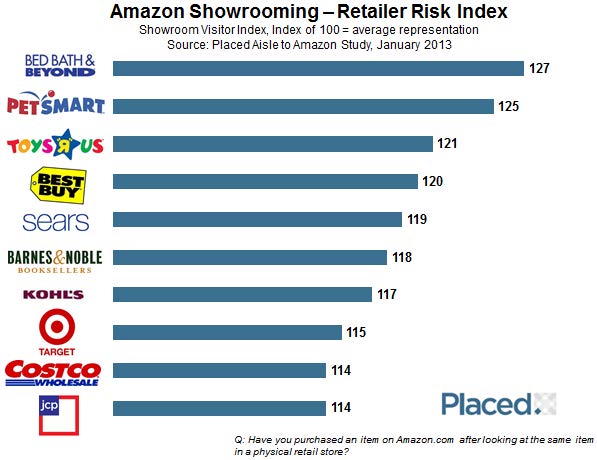The Retailer with the Highest Showrooming Risk Is

The momentum of mobile has made showrooming a growing threat to brick-and-mortar retailers. A new study, however, reveals that some retailers are at higher risk than others.
The Aisle to Amazon study from location analytics company Placed unsurprisingly identified Best Buy and Target as high-risk retailers when it comes to consumers viewing products offline and then making purchases online. That being said, Best Buy and Target are actually not the most at risk when it comes to showrooming. In fact, Bed Bath & Beyond, PetSmart and Toys 'R' Us all face greater risk, with Amazon shoppers being 27 percent more likely to visit Bed Bath & Beyond, 25 percent more likely to visit PetSmart and 21 percent more likely to visit Toys 'R' Us before making a purchase online.
"Amazon was the clear winner in ecommerce 1.0, and unless brick-and-mortar retailers shift from reactive to proactive, Amazon will win ecommerce 2.0 on the backs of offline retailers," said David Shim, Founder and CEO at Placed. "All the attention to date has been on Target and Best Buy as the early victims of showrooming, but significantly more retailers are at risk. Retailers need to know that it's not a question of if or when showrooming will impact their business, as an aisle to Amazon is already in their store."

In an attempt to combat showrooming, both Best Buy and Target recently announced Amazon price-matching policies, but this isn't the only way that brick-and-mortar retailers can combat Amazon shoppers. Other strategies include:
1. Selling exclusive products - retailers can take Amazon out of the equation by selling customizable products or products that are exclusive to their brand or a brick-and-mortar location.
2. Integrating online features offline - If consumers are already shopping in-stores with their mobile phones, why not make the process easier? One way merchants can do this is by posting QR codes next to items that will take consumers to product reviews when scanned. Moreover, merchants can launch location-based promotions on platforms like Foursquare, such as a coupon for 25 percent off an in-store purchase when someone checks-in. This allows consumers to participate with mobile, while also giving them an incentive to make an immediate purchase.
3. Maintaining great service - One of the biggest advantages brick-and-mortar merchants have over online retailers is their ability to provide excellent service to any customer that walks through the door. This is why merchants should make sure that every member on their staff has a good attitude and is educated about the products and services that are being sold.







